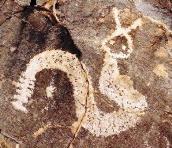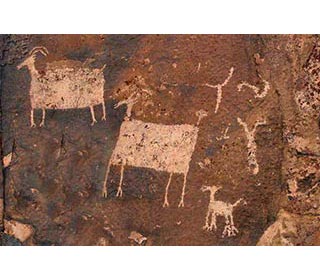Creating Petroglyphs
Petroglyphs are created by chipping, carving, engraving, scraping or grinding the surface of rocks (called the outer patina) to reveal a lighter rock of stone beneath. The term 'pecking' is also used in creating Petroglyphs. Pecked petroglyphs are produced by a process of indirect percussion, involving the use of a hammer in one hand and a chisel in the other. The above picture of Petroglyphs found in Utah illustrate how the technique was used and the resulting Petroglyphs, the following petroglyph illustrates s horned serpent. Antlers and horns signified spiritual power, especially when applied to animals that did not ordinarily have them such as Snakes and serpents. 
Horned Serpent Petroglyph Rock Carving Petroglyphs - Symbols and Signs at Chaco Canyon
The meanings of signs and the types of symbols shown in the picture of the following Petroglyphs at Chaco Canyon are extremely interesting. Chaco Canyon is located within the San Juan Basin of northwestern New Mexico and the the vast Colorado Plateau. Chaco Canyon was inhabited by the Ancient Pueblo People, who are more commonly known as the Anasazi. The main figure of the man in the Petroglyph of the man is believed to be a Shaman who is connecting to the spiral symbol which was a powerful sun and life symbol. Current theories speculate that the position of the spirals on the Petroglyphs were of major importance and that at certain times of the year a shaft of light, referred to as the 'Sun Dagger', produced a 'light show' on the spiral symbols. These effects occurred the Summer and Winter Solstice and during the spring (vernal) and fall (autumnal) equinoxes and confirmed that these ancient people had significant knowledge of astrological signs. These times of the year were extremely important as they provided bench marks for when crops needed to be planted and when important sun rituals and religious ceremonies took place. For additional information refer to the Hopi Prophecy Rock. Yei Petroglyphs
The Petroglyphs below feature Yei Symbols. The Navajo Yei Spirit is believed to mediate between humans and the Great Spirit and are usually shown carrying pine boughs or yucca strips. Depictions of Navajo Yei spirits are commonly found on Petroglyphs and Sand Paintings. Yei derives from the word Yeibicheii meaning the Holy People. 
Yei Petroglyphs | 

